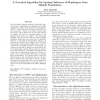21 search results - page 2 / 5 » Linear Reduction for Haplotype Inference |
ISMB
2000
13 years 7 months ago
2000
The next phase of human genomics will involve largescale screens of populations for signi cant DNA polymorphisms, notably single nucleotide polymorphisms SNP's. Dense human S...
JMLR
2010
13 years 13 days ago
2010
Working within the decision-theoretic framework for causal inference, we study the properties of "sufficient covariates", which support causal inference from observation...
CVPR
2009
IEEE
15 years 23 days ago
2009
IEEE
Non-linear dimensionality reductionmethods are powerful techniques to deal with
high-dimensional datasets. However, they often are susceptible to local minima
and perform poorly ...
ECCV
2006
Springer
14 years 7 months ago
2006
Springer
Abstract. We present a novel method for dimensionality reduction and recognition based on Linear Discriminant Analysis (LDA), which specifically deals with the Small Sample Size (S...
SPEECH
1998
13 years 5 months ago
1998
We consider the problem of obtaining a reduced dimension representation of electropalatographic (EPG) data. An unsupervised learning approach based on latent variable modelling is...

